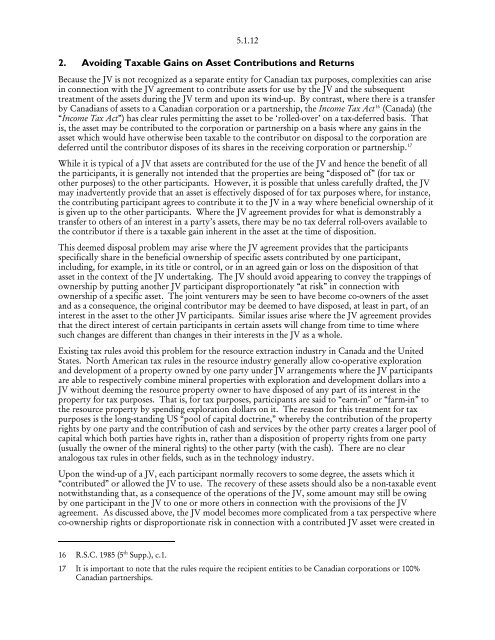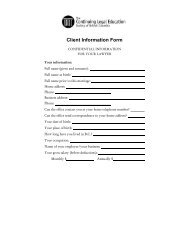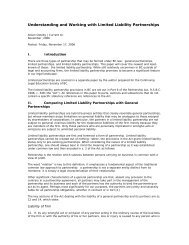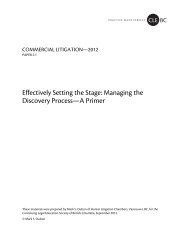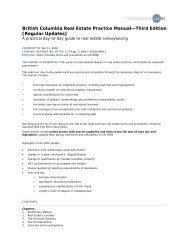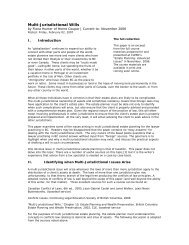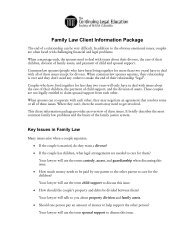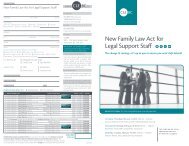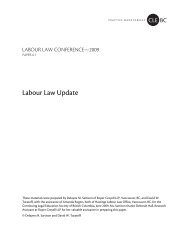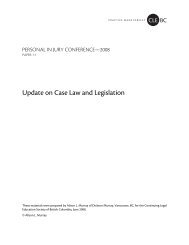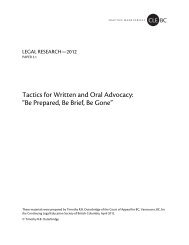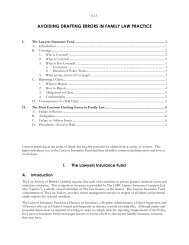Joint Ventures-The Limited Fiduciary Relationship Structure
Joint Ventures-The Limited Fiduciary Relationship Structure
Joint Ventures-The Limited Fiduciary Relationship Structure
You also want an ePaper? Increase the reach of your titles
YUMPU automatically turns print PDFs into web optimized ePapers that Google loves.
5.1.12<br />
2. Avoiding Taxable Gains on Asset Contributions and Returns<br />
Because the JV is not recognized as a separate entity for Canadian tax purposes, complexities can arise<br />
in connection with the JV agreement to contribute assets for use by the JV and the subsequent<br />
treatment of the assets during the JV term and upon its wind-up. By contrast, where there is a transfer<br />
by Canadians of assets to a Canadian corporation or a partnership, the Income Tax Act 16 (Canada) (the<br />
“Income Tax Act”) has clear rules permitting the asset to be ‘rolled-over’ on a tax-deferred basis. That<br />
is, the asset may be contributed to the corporation or partnership on a basis where any gains in the<br />
asset which would have otherwise been taxable to the contributor on disposal to the corporation are<br />
deferred until the contributor disposes of its shares in the receiving corporation or partnership. 17<br />
While it is typical of a JV that assets are contributed for the use of the JV and hence the benefit of all<br />
the participants, it is generally not intended that the properties are being “disposed of” (for tax or<br />
other purposes) to the other participants. However, it is possible that unless carefully drafted, the JV<br />
may inadvertently provide that an asset is effectively disposed of for tax purposes where, for instance,<br />
the contributing participant agrees to contribute it to the JV in a way where beneficial ownership of it<br />
is given up to the other participants. Where the JV agreement provides for what is demonstrably a<br />
transfer to others of an interest in a party’s assets, there may be no tax deferral roll-overs available to<br />
the contributor if there is a taxable gain inherent in the asset at the time of disposition.<br />
This deemed disposal problem may arise where the JV agreement provides that the participants<br />
specifically share in the beneficial ownership of specific assets contributed by one participant,<br />
including, for example, in its title or control, or in an agreed gain or loss on the disposition of that<br />
asset in the context of the JV undertaking. <strong>The</strong> JV should avoid appearing to convey the trappings of<br />
ownership by putting another JV participant disproportionately “at risk” in connection with<br />
ownership of a specific asset. <strong>The</strong> joint venturers may be seen to have become co-owners of the asset<br />
and as a consequence, the original contributor may be deemed to have disposed, at least in part, of an<br />
interest in the asset to the other JV participants. Similar issues arise where the JV agreement provides<br />
that the direct interest of certain participants in certain assets will change from time to time where<br />
such changes are different than changes in their interests in the JV as a whole.<br />
Existing tax rules avoid this problem for the resource extraction industry in Canada and the United<br />
States. North American tax rules in the resource industry generally allow co-operative exploration<br />
and development of a property owned by one party under JV arrangements where the JV participants<br />
are able to respectively combine mineral properties with exploration and development dollars into a<br />
JV without deeming the resource property owner to have disposed of any part of its interest in the<br />
property for tax purposes. That is, for tax purposes, participants are said to “earn-in” or “farm-in” to<br />
the resource property by spending exploration dollars on it. <strong>The</strong> reason for this treatment for tax<br />
purposes is the long-standing US “pool of capital doctrine,” whereby the contribution of the property<br />
rights by one party and the contribution of cash and services by the other party creates a larger pool of<br />
capital which both parties have rights in, rather than a disposition of property rights from one party<br />
(usually the owner of the mineral rights) to the other party (with the cash). <strong>The</strong>re are no clear<br />
analogous tax rules in other fields, such as in the technology industry.<br />
Upon the wind-up of a JV, each participant normally recovers to some degree, the assets which it<br />
“contributed” or allowed the JV to use. <strong>The</strong> recovery of these assets should also be a non-taxable event<br />
notwithstanding that, as a consequence of the operations of the JV, some amount may still be owing<br />
by one participant in the JV to one or more others in connection with the provisions of the JV<br />
agreement. As discussed above, the JV model becomes more complicated from a tax perspective where<br />
co-ownership rights or disproportionate risk in connection with a contributed JV asset were created in<br />
16 R.S.C. 1985 (5 th Supp.), c.1.<br />
17 It is important to note that the rules require the recipient entities to be Canadian corporations or 100%<br />
Canadian partnerships.


